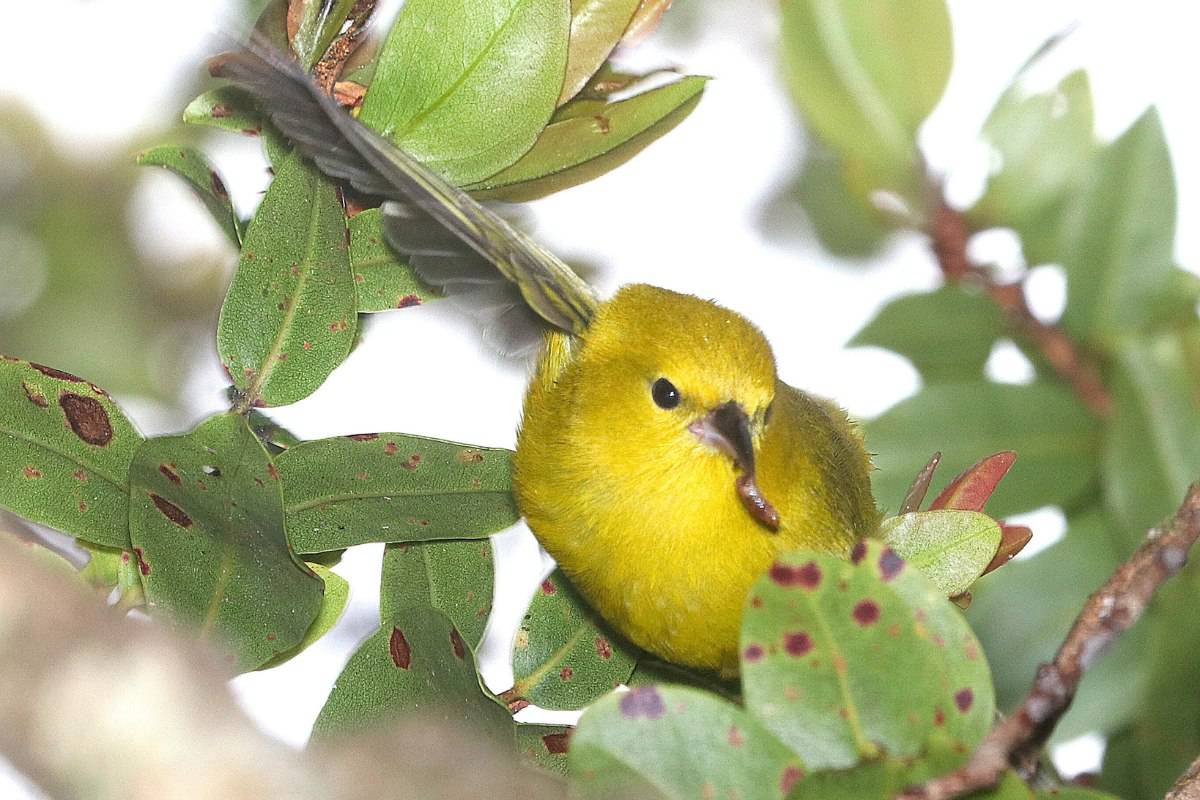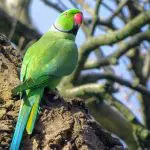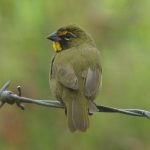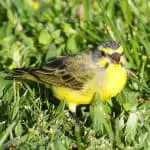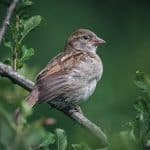Common Name: ʻAnianiau
Scientific Name: (Magumma parva)| Size | Diet | Range in Hawaii | Status in Hawaii |
|---|---|---|---|
| 3.5 in. | insects, nectar | Kaua'i | Vulnerable |
The ʻAnianiau, also known as Magumma parva, is a small bird species that is native and endemic to the Hawaiian islands. With its bright yellow plumage and unique foraging behavior, the ʻAnianiau is a fascinating bird species that has captured the attention of birdwatchers and avian enthusiasts around the world.
In this article, we will explore the world of the ʻAnianiau, its unique characteristics, and its presence in Hawaii.
ʻAnianiau
Appearance
The ʻAnianiau is a petite wonder of the Hawaiian forests. Measuring only about 3.5 inches in length, it’s one of the tiniest bird species on the islands.
Its vibrant plumage features shades of green and yellow, adorned with subtle streaks that shimmer in the dappled sunlight. Its delicate features are accentuated by a slender, slightly curved bill designed for precision feeding.
Diet
The diet of the ʻAnianiau is a delightful exploration of its specialized tastes. This tiny Hawaiian bird primarily feeds on nectar, sipping from the vibrant blossoms of native flowering plants. It harmoniously dances among the blooms, while occasionally supplementing its diet with tiny insects, showcasing its ability to adapt to the ever-changing rhythms of its island habitat.
Nesting
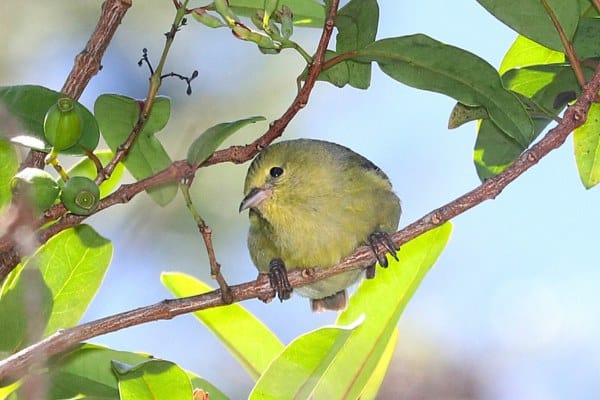
Picture a verdant haven, where sunlight filters through the leaves like liquid gold. Here, the ʻanianiau’s nest hangs like a suspended jewel, suspended from the fragile bough of a native tree.
Utilizing nature’s finest threads, such as mosses, spider silk, and lichen, the ʻanianiau deftly crafts its minuscule haven. But what truly captivates the heart is the symphony of color that adorns its nest—a delicate medley of petals, feathers, and fern fronds, all woven together with meticulous care.
As if crafting a mandala of life, the ʻanianiau’s nest is a testament to the harmonious coexistence between its creator and the surrounding environment. It’s a sanctuary within a sanctuary, where the songbird nurtures its future generation with unwavering dedication. The nest, no larger than a teacup, cradles eggs as precious as porcelain, each one a promise of life in its purest form.
Behavior
With a zest for life that rivals the vibrant hues of tropical flowers, the ʻanianiau darts and dances among the forest’s verdant tapestry. Its delicate frame belies a tenacious spirit, as it fearlessly flits through the lush foliage in search of sustenance. A connoisseur of nectar, the ʻanianiau is known to delicately probe flowers with its needle-like bill, savoring the sweet elixir that sustains its vibrant energy.
Intriguingly social, these avian gems often gather in small, lively flocks, their musical calls blending harmoniously with the rustling leaves. Their interactions are a symphony of movement, an intricate ballet that hints at the intricate choreography of nature itself. Observing their playful pursuits and animated exchanges, it’s evident that the ʻanianiau thrives on camaraderie, finding strength and purpose in its avian companions.
But it’s during the nesting season that the ʻanianiau truly reveals its heartwarming nature. Parental dedication knows no bounds as these birds meticulously construct their lichen-laden nests, perched delicately on slender branches. Amidst the whispering leaves, they delicately tend to their precious eggs, embodying a nurturing spirit that bridges the gap between the feathered world and our own.
Habitat
The ʻanianiau finds its ethereal haven amidst the lush embrace of Hawaii’s enchanting rainforests. This enchanting avian calls the native Ohia forests home, an ecosystem as ancient as time, where the towering trees stand as sentinels and the air hums with the chorus of life.
Range
The ‘Anianiau, a native and endemic Hawaiian bird, once roamed Kaua’i’s lowlands but now thrives at higher elevations above 600 meters. In recent times, observations of this delicate bird on the Alaka’i Plateau show a glimpse of its ongoing tale of survival.
Conservation Status
The ʻAnianiau (Magumma parva) is classified as “Vulnerable” on the IUCN Red List, underscoring its heightened vulnerability to various threats. This status emphasizes the importance of concerted conservation measures to protect this diminutive Hawaiian bird and its vital role within the island’s ecosystems.
Interesting Facts
1. Cultural significance
In Hawaiian culture, birds like the ʻanianiau hold spiritual and cultural significance. They are often seen as messengers, connecting the human world with the natural world and carrying symbolic messages.
2. Unique name
The name “ʻanianiau” is derived from the Hawaiian language and is a representation of its high-pitched, musical call. It’s a name that reflects the bird’s essence and its role in the symphony of the rainforest.
3. Feather molt patterns
Like many birds, the ʻanianiau undergoes molting, a process where old feathers are shed and replaced with new ones. Interestingly, they follow a distinct molt pattern, shedding their feathers in a particular sequence that scientists study to better understand their life cycle.
4. Endemic flower symbiosis
Some native Hawaiian plants have evolved in close association with specific bird species like the ʻanianiau. These plants produce flowers that are perfectly adapted for the bird’s bill, creating a mutualistic relationship that benefits both species.
5. Intricate courtship
During courtship, male ʻanianiau may perform acrobatic displays and show off their bright plumage to attract females. This courtship behavior adds a touch of drama and color to the rainforest’s already vibrant stage.
Frequently Asked Questions
1. Are there any educational programs focused on the ʻanianiau?
Some educational initiatives and nature centers in Hawaii offer programs and resources to raise awareness about the ʻanianiau’s conservation needs. These programs aim to inspire local communities and visitors to become stewards of the species and its habitat.
2. What is the significance of the ʻanianiau’s scientific name, Magumma parva?
The scientific name “Magumma parva” refers to the bird’s small size. “Magumma” is derived from the Latin word “magnum,” meaning “great,” while “parva” means “small.” This name encapsulates the bird’s paradoxical combination of vibrant presence in a tiny package.
3. Are there conservation efforts for the ʻanianiau?
Yes, conservation organizations are actively working to protect the ʻanianiau and its habitat. Efforts include habitat restoration, controlling invasive species, and raising awareness about the importance of preserving Hawaii’s unique biodiversity.
4. Can the ʻanianiau be seen by tourists?
While the ʻanianiau can be challenging to spot due to its small size and rapid movements, birdwatchers and nature enthusiasts visiting Hawaiian rainforests might have the opportunity to catch a glimpse of these elusive birds.
5. What distinguishes the ʻanianiau from other Hawaiian honeycreepers?
The ʻanianiau’s small size, vibrant yellow plumage, and high-pitched calls set it apart from other honeycreeper species. Its unique nesting behavior, reliance on nectar, and preference for higher elevations also contribute to its distinctiveness.
